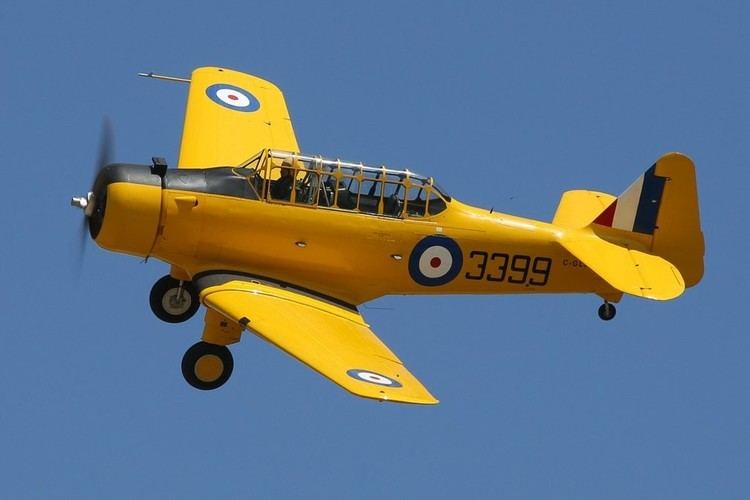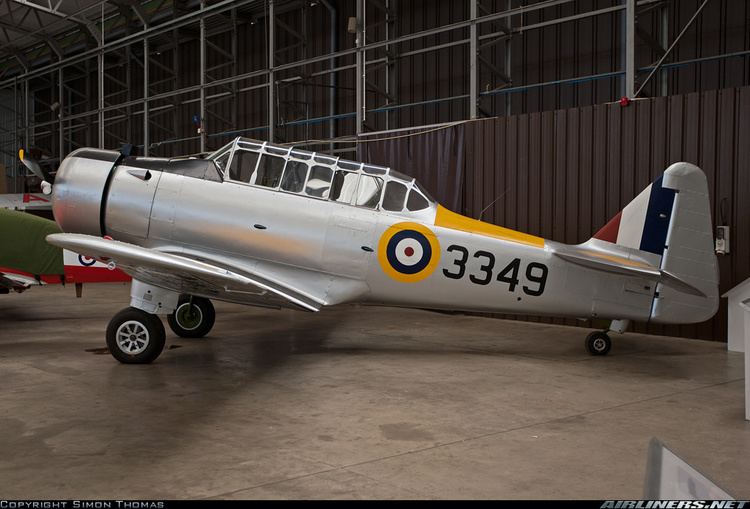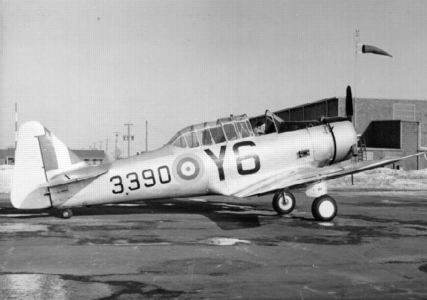Top speed 267 km/h First flight February 12, 1940 | Introduced 1940 | |
 | ||
The North American NA-64 (NA-64 P-2 or NAA-64 P-2 in French service, Yale in Canadian service) is a low-wing single piston engine monoplane advanced trainer aircraft that was built for the French Armée de l'Air and Aeronavale and served with the Royal Canadian Air Force and Luftwaffe as a captured aircraft or Beuteflugzeug during World War II.
Contents
- Design and development
- France
- Canada
- Germany
- Operators
- Survivorsaircraft on display
- Specifications
- References

Design and development

Ordered as a follow-on to the NA-57 as a two-seat advanced trainer, the NA-64 P-2/NAA-64 P-2 represented a major structural improvement, with a longer all-metal fuselage replacing the fabric covered fuselage of the NA-57. As well as metal skin replacing the fabric on the fuselage, the fin was changed from having a corrugated skin to being a smooth stressed skin structure and was moved slightly aft, lengthening the rear fuselage while the engine was moved forward to maintain the center of gravity. The rudder was also changed from the rounded shape used previously to one with a roughly triangular shape with the broadest part being at the bottom to improve handling at high angles of attack. In one respect however, it was a step backwards from its immediate predecessor, the BT-14, with which it is often confused, in that the earlier straight wings were used with the result that in RCAF service, when compared to the later and more powerful Harvard II it was flown alongside, it had different handling characteristics and lower performance.
France

The NA-64 P-2 was built for the French Armée de l'Air and Aéronavale in 1939–1940, which ordered 200 and 30 respectively. Of these, 111 had been delivered before France surrendered to the Germans after the Battle of France. In France, the NA-64, like the NA-57 before it, was known as the North, and was designated as NAA-64 P-2 (abbreviated from North American Aviation modèle 64 perfectionnement, 2 places (North American Aviation model 64 advanced trainer, 2 seats)) but were sometimes attached to reconnaissance units. A small number escaped the Germans to be used by the Vichy French Air Force. Two examples in North Africa survived into the postwar years, having been operated alongside NA-57s, the last only being retired in 1949.
Canada

The remaining 119 undelivered aircraft were bought up by the British Purchasing Commission and transferred to the Royal Canadian Air Force (RCAF) for the British Commonwealth Air Training Plan between August and September 1940, and all were operational by November The type was named the Yale Mk.I following British naming practice of naming trainers after education institutions and US-supplied aircraft after American locations, in this case, Yale University, and were used initially as intermediate pilot trainers taking pilots from the de Havilland Tiger Moth and Fleet Finch to the much faster and more complex North American Harvard, until this category was dispensed with as being unnecessary. They were then relegated for use as airborne wireless radio trainers, along with the contemporary Fleet Fort intermediate trainer in 1943. Prior to service entry, the throttle and engine mixture controls were modified from the system used by the French whereby the throttle was pulled back to increase power, and the mixture control pulled back to lean out the mixture, to the system used on the Harvard. The Yale appeared in the movie Captains of the Clouds. The RCAF sold all surviving examples off as scrap in 1946 but over 30 survive today as a result of a large number of them being bought surplus by a single farmer, with about 15 currently in airworthy condition.
Germany

The NAA-64s captured from the French were used by the German Luftwaffe for all types of flight training, from basic flying to advanced fighter tactics. Dive bomber schools and target tug units and even combat squadrons all used the NAA-64, as they were designated by the Luftwaffe, from the tail markings of the French examples. At least one was used by the Zirkus Rosarius to familiarize German aircrew with the handling of American aircraft before they evaluated captured aircraft.
Operators
Survivors/aircraft on display
There are many surviving NA-64 Yales today because of Ernie Simmons, a farmer from near Tillsonburg, Ontario. Simmons bought 39 Yales in 1946, along with seven Fairey Swordfish and a Westland Lysander and kept them on his farm until he died in 1970. Most were auctioned the same year, and many have been restored by museums and warbird enthusiasts. All surviving Yales are from the Simmons collection. Two examples have been subsequently lost, a major hangar fire took the Musée de l'air et de l'espace's NA-64 3415/64-2224, and 3454/64-2165 was destroyed as the result of a flying accident. Several Yales have been painted or partially modified as BT-14s Additionally, over a dozen are privately owned in Canada, the US, and Europe or are not accessible, and additional airframes may be held by some museums as a source of spares.
Specifications
Data from North American Aviation, Manuel de Pilotage de l'Avion NA-64 P-2 (Avion de Perfectionnement), 1940, pp.8-9
General characteristics
Performance
Armament
